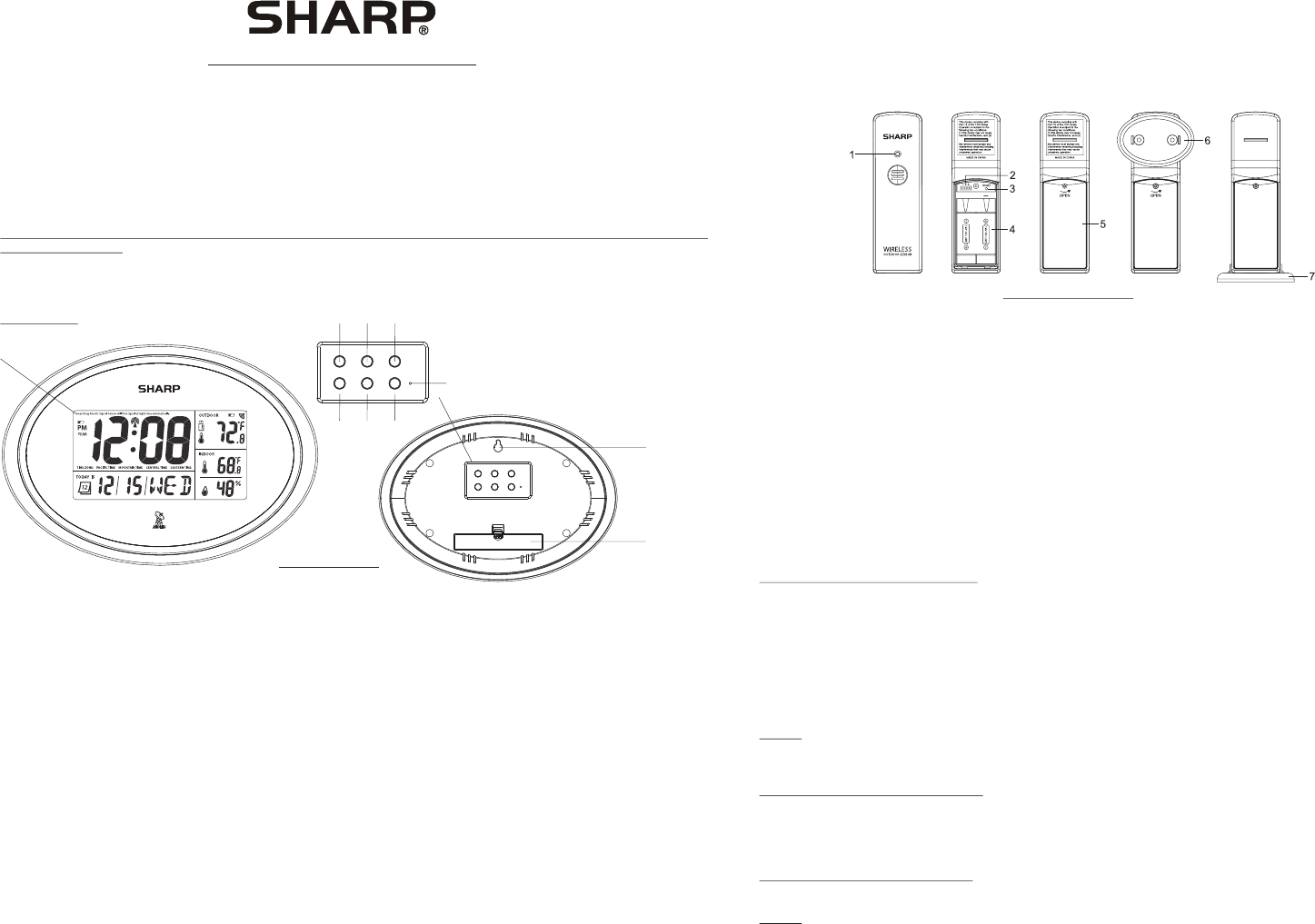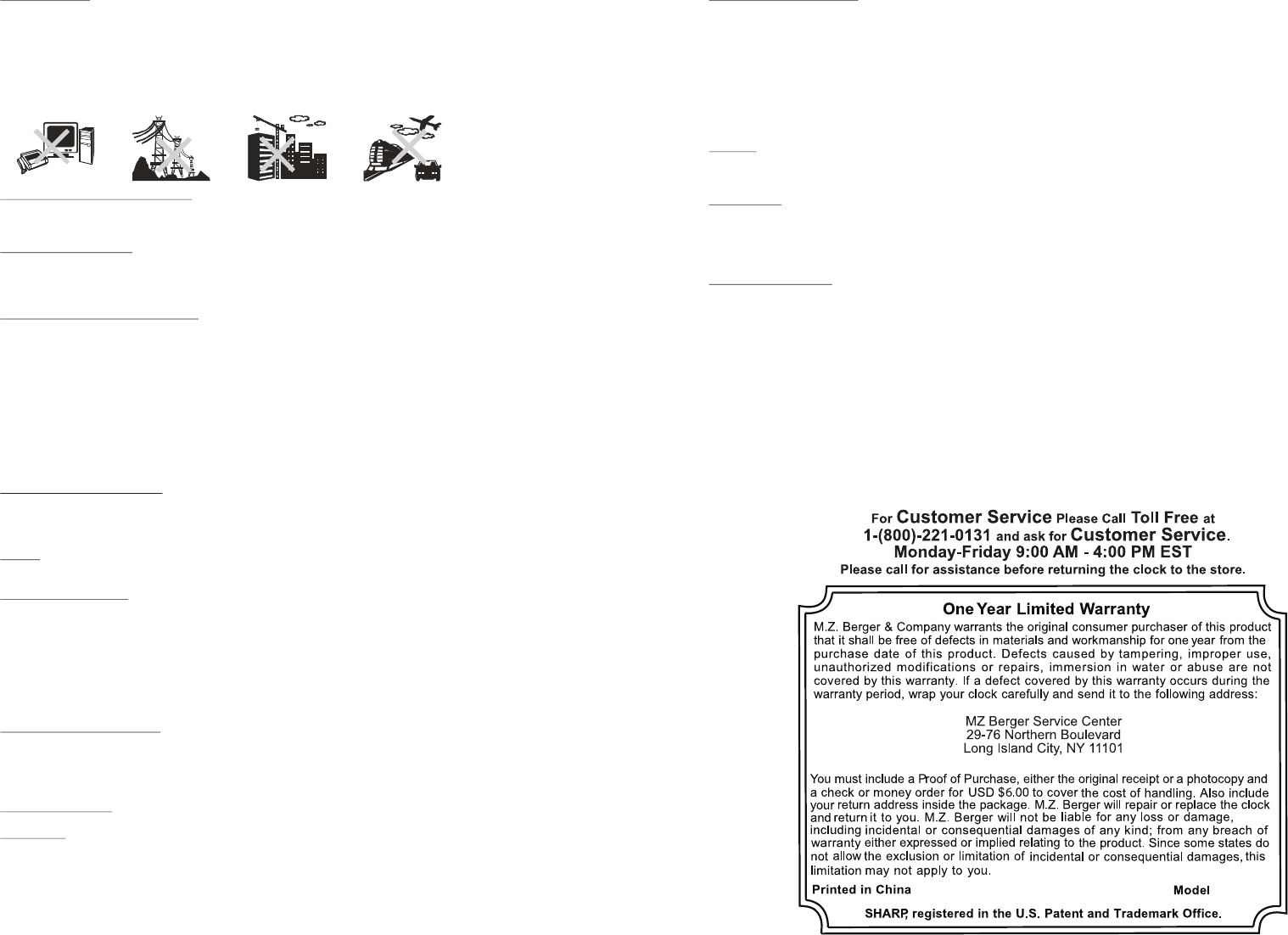Digital Gallery Global SPC936 Atomic Wall Clock with Wireless Indoor / Outdoor Temperature User Manual SPC936 IM
Digital Gallery Global Limited Atomic Wall Clock with Wireless Indoor / Outdoor Temperature SPC936 IM
User Manual

Instructions & Warranty
Thank you for your purchase of this quality clock. The utmost care has gone into the design and manufacture of your
clock. Please read these instructions and store them in a safe place for future reference.
The receiver unit has a clear, easy-to-read display that shows indoor temperature and humidity, outdoor temperature,
time, month, date, day. The remote sensor transmits the outdoor temperature. To receive the outdoor temperature,
place the sensor anywhere within 30 meters; the 433.92MHz technology means no wire installation is required.
The Atomic Clock will always be accurate to within one second as it receives daily WWVB updates. Daylight Saving
Time also automatically updates so there is no need to re-set the clock manually!
IMPORTANT: If the Atomic Clock does not receive the WWVB signal immediately, wait overnight and it will be
set in the morning.
The clock has a built in receiver that automatically synchronizes itself with the WWVB radio signal broadcast by the
US Government’s National Institute of Standards & Technology (NIST) in Fort Collins, Colorado.
FEATURES:
Atomic Clock
1. CLOCK DISPLAY:
- Displays time in hours and minutes; calendar display of day, month and year; indoor temperature and humidity;
outdoor temperature; signal strength indicator; daylight saving (DST); and time zone.
2. Set BUTTON:
- In TIME mode, press and hold the SET button to enter the time setting mode.
- Press the SET button to confirm the setting and enter the next setting.
3. Channel BUTTON:
- In the normal mode, press the button to switch the between channel 1, 2 and 3 to receive the 433.92MHz signal;
press and hold the button for 3 seconds will pairing with the outdoor remote sensor.
4. + BUTTON:
- In the TIME setting mode, press it to increase the setting values. Hold the button for 3 seconds, the display will
change rapidly.
5. -/wave BUTTON:
- In the TIME setting mode, press the button to decrease the setting values. Hold the button for 3 seconds, the
display will change rapidly.
- In the normal mode, press and hold the button for 3 seconds for receive the RCC signal immediately.
- During the RCC receiving period, press the button again to stop the RCC reception.
6. 12/24 BUTTON:
- In normal mode, press the button to switch 12/24 time display format.
7. ℃/℉ BUTTON:
- In normal mode, press the button to switch temperature unit ℃/℉.
DST
1
2 4 6
3 5 7
8
9
10
Set + 12/2 4
Chan nel -/ wave ℃/℉
Rese t
8. Reset BUTTON:
- In case of malfunction, press RESET button to reset all values to default values.
9. WALL MOUNT
10. BATTERY COMPARTMENT AND DOOR:
- Use 2 AA size batteries.
Remote Transmitter
1. LED INDICATOR:
- LED Flashes when the remote unit transmits a reading
2. CHANNEL SLIDE SWITCH:
- Assign the transmitter to channel 1, 2 or 3 to receive 433.92MHz signal
3. RESET BUTTON:
- Press it to restart the transmitter and return all values to default values.
4. BATTERY COMPARTMENT:
- Use 2 AA Size batteries.
5. BATTERY DOOR
6. WALL MOUNT
7. TABLE STAND
SETTING UP THE TRANSMITTER:
1. Remove the battery door and insert 2 AA batteries into the battery compartment and follow the polarities marked.
2. Slide the switch to Channel 1. Press the RESET button to set the transmitter.
3. Press the CHANNEL button at the back of the clock to set channel 1.
4. Lock the transmitter battery door with the screw.
5. Place the units away from metal objects and electrical appliances to minimize interference. Position the receiver
within the effective transmission range 30 meters in usual circumstances.
6. If Channel 1 signal is not received properly, change the transmitter slide button to Channel 2 or 3. Press CHANNEL
button of the clock to 2 or 3 respectively. Press and hold the CHANNEL button for three seconds. The unit will start
to find the new channel.
NOTE:
1. To receive the transmitter signal, the channels of receiver and transmitter must match each other.
2. Once the channel is assigned to transmitter, you can only change it by removing the batteries or resetting the unit.
SETTING UP THE ATOMIC CLOCK:
1. Remove the battery door from the back of the weather station and insert 2 AA batteries. Insert them according to
the marked polarity.
2. Replace the battery door.
3. Press the RESET button on the back of the clock to set and synchronize the transmitter automatically.
SIGNAL STRENGTH INDICATOR:
The signal indicator displays signal strength in 4 levels. Wave segment flashing means time signals are being received.
NOTE:
1. The unit will automatically search for the time signal at 2:00 (3:00, 4:00, 5:00,6:00 is also available if the signal was
not received at 2:00)
2. Closed area such as airport, basement, tower block or factory is not recommended.

SPC936
SUGGESTION:
Make sure you read the instructions before operating this clock. We have developed this sophisticated instrument for
the best reception performance; however, the signal transmitted from USA Atomic Clock transmitter will be affected in
certain situations. We advise you to note the following instructions:
1. It is strongly recommended to start this clock at night and let the clock receive the signal automatically past midnight.
2. Always place the unit away from interfering sources such as TV set, computer, etc.
3. Avoid placing the unit on or next to metal plates.
4. Areas with access to windows is recommended for better reception.
5. Do not start reception in moving articles such as vehicles or trains.
DAYLIGHT SAVING TIME (DST):
The clock has programmed to automatically switch when the daylight saving time is in effect. Your clock will show DST
during the summer time if you turn on the DST.
TIME ZONE SETTING:
The default time zone is PACIFIC. If your location is not in the Pacific, set the time zone by pressing -/wave button to
change the Pacific Time/ Mountain Time/ Central Time/ Eastern Time zone in the normal time mode and will disappear
after setting.
TIME AND CALENDAR SETTING:
Time and calendar can be set manually. As soon as the transmitter signal is received again, the clock will automatically
synchronize with the exact time and calendar.
1. Press and hold the SET button on the back of the clock for 3 seconds, the year digits will be flash.
2. Press the + button and -/wave button to change the value.
3. Press the SET button once until the Month digit flashes, press the + button and -/wave button to change it's value.
4. Press the SET button once until the Date digit flashes, Press the + button and -/wave button to change it's value.
5. Repeat the above operation to set the below data in this sequence: Month>Date>Language>Hour>Minute>
DST(on/off).
6. Press the SET button to save and exit the setting mode; or let it exit automatically 20 seconds later without pressing
any key.
BATTERY REPLACEMENT:
If the low battery indicator appears beside the outdoor temperature of main unit, it indicates that the transmitter
batteries need replacement. If the low battery indicator is displayed at the top left corner, it indicates that the atomic
clock batteries need replacement.
NOTE:
Attention! Please dispose of used unit or batteries in an ecologically safe manner.
BATTERY WARNING:
- Clean the battery contacts and also those of the device prior to battery installation. Follow the polarity (+) and (-)
to place battery.
- Do not mix old and new batteries.
- Do not mix Alkaline, Standard (Carbon - Zinc), or Rechargeable (Nickel - Cadmium) batteries.
- Incorrect battery placement will damage the clock movement and battery may leak.
- Exhausted battery is to be removed from the product.
- Remove batteries from equipment which is not to be used for an extended period of time.
- Do not dispose of batteries in fire. Batteries may explode or leak.
USING THE WALL MOUNT:
The receiver and transmitter both have the desktop and wall mounting structure.
- For the Atomic Clock, use the recessed hold on the back of the clock to hang it.
- For the Transmitter, hang or place the separate wall-mounting part in an area protected from direct rain. Once the
stand is mounted, place the transmitter into the stand on the wall.
SPECIFICATIONS:
MAIN UNIT
Recommended operating range: 0℃ to 45℃, 32℉ to 113℉
Resolution: 0.1℃/℉(above 0℃/32℉), 1℃/℉(below 0℃/32℉)
Humidity measuring range: 20% RH to 95%RH
Recommended operating range: 20% RH to 95%RH
Resolution: 1%RH
Calendar range: from year 2000 to 2099
Radio controlled signal: WWVB
REMOTE TRANSMITTER
Recommended operating range: -50℃ to 70℃, -122℉ to 158℉
Resolution: 0.1℃/℉(above 0℃/32℉), 1℃/℉(below 0℃/32℉)
Humidity measuring range: 20% RH to 95%RH
Operating range: 20% RH to 95%RH
Resolution: 1%RH
RF transmission frequency: 433.92MHz
Remote transmitter: 1 unit
RF transmission range: maximum 30 meters
Temperature sensing cycle: around 50 seconds
POWER
Main unit: 3V, use 2 x AA 1.5V alkaline battery
Remote transmitter: 3V, use 2 x AA 1.5V alkaline battery
DIMENSION
Main unit: 300(W) x 210(H) x 25.5(D)mm
11.8(W) x 8.3(H) x 1(D)inch
Remote transmitter: 40(W) x 130(H) x 24(D)mm
1.6(W) x 5.1(H) x 0.9(D)inch
FCC INFORMATION:
This equipment has been tested and found to comply with the limits for a Class B digital device, pursuant to Part 15 of
the FCC Rules. These limits are designed to provide reasonable protection against harmful interference in a residential
installation. This equipment generates, uses, and can radiate radio frequency energy and, if not installed and used in
accordance with the instructions, may cause harmful interference to radio communications. However, there is no
guarantee that interference will not occur in a particular installation. If this equipment does cause harmful interference
to radio or television reception, which can be determined by turning the equipment off and on, the user is encouraged
to try to correct the interference by one or more of the following measures:
- Reorient or relocate the receiving antenna.
- Increase the separation between the equipment and receiver.
- Connect the equipment into an outlet on a circuit different from that to which the receiver is connected.
- Consult the dealer or an experienced radio/TV technician for help.
This device complies with Part 15 of the FCC Rules. Operation is subject to the following two conditions:
(1) This device may not cause harmful interference, and
(2) This device must accept any interference received, including interference that may cause undesired operation.